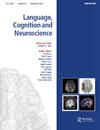拟人代词与拟人代词:英语和他加禄语中流利和不流利失语症的比较
IF 1.8
3区 医学
Q2 AUDIOLOGY & SPEECH-LANGUAGE PATHOLOGY
引用次数: 0
摘要
谓语代词直接指代语言外的世界(如 "拦住她!"),而拟人代词指代话语中引入的元素(如 "我最好的朋友是玛丽。 约翰很喜欢她")。...本文章由计算机程序翻译,如有差异,请以英文原文为准。
Deictic vs. anaphoric pronouns: a comparison of fluent and non-fluent aphasia in English and Tagalog
Deictic pronouns refer directly to the extralinguistic world (as in Stop her!), while anaphoric pronouns refer to elements introduced in discourse (as in My best friend is Mary. John adores her.). ...
求助全文
通过发布文献求助,成功后即可免费获取论文全文。
去求助
来源期刊

Language Cognition and Neuroscience
AUDIOLOGY & SPEECH-LANGUAGE PATHOLOGY-BEHAVIORAL SCIENCES
CiteScore
4.50
自引率
13.00%
发文量
70
期刊介绍:
Language, Cognition and Neuroscience (formerly titled Language and Cognitive Processes) publishes high-quality papers taking an interdisciplinary approach to the study of brain and language, and promotes studies that integrate cognitive theoretical accounts of language and its neural bases. We publish both high quality, theoretically-motivated cognitive behavioural studies of language function, and papers which integrate cognitive theoretical accounts of language with its neurobiological foundations.
The study of language function from a cognitive neuroscience perspective has attracted intensive research interest over the last 20 years, and the development of neuroscience methodologies has significantly broadened the empirical scope of all language research. Both hemodynamic imaging and electrophysiological approaches provide new perspectives on the representation and processing of language, and place important constraints on the development of theoretical accounts of language function and its neurobiological context.
 求助内容:
求助内容: 应助结果提醒方式:
应助结果提醒方式:


